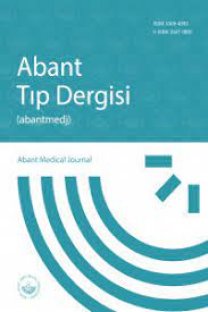Gastrointestinal ve Pankreatik Nöroendokrin Tümörlerde Prognostik Parametreler
gastroenteropankreatik, nöroendokrin, tümör
The Prognostic Parameters in Gastrointestinal and Pancreatic Neuroendocrine Tumors
gastroenteropancreatic, neuroendocrine, tumor,
___
- Alexiev BA, Drachenberg CB, Papadimitriou JC. Endocrine tumors of the gastrointestinal tract and pancreas: Grading, tumor size and proliferation index do not predict malignant behavior. Diagn Pathol 2007, 2:28.
- Modlin IM, Shapiro MD, Kidd M. Siegfried Obendorfer: origins and perspective of carcinoid tumors. Hum Pathol 2004: 35:1440- 51
- Grame-Cook F, Neuroendocrine tumors of the gastrointestinal tract and appendix. In: Odse RD, Goldblum JR. Surgical Pathology of the GI Tract, Liver, Biliary Tract and Pancreas. 2nd reved. Philadelphia, 2009: 653-693
- Klöppel G, Rindi G, Anlauf M, Perren A, Komminoth P. Site- specific biology and pathology of gastroenteropancreatic neuro- endocrine tumors. Virchows Arch. 2007;451 Suppl 1:S9-27.
- Van Gompel JJ, Sippel RS, Warner TF, Chen H. Gastrointestinal carcinoid tumors: factors that predict outcome. World J Surg. 2004;28:387-92.
- Rorstad O. prognostic indicators for cardinoid neuroendocrine tumors of the gastrointestinal tract. J. Surg. Oncol 2005;89:151- 160
- Oberg K, Akerström G, Rindi G, Jelic S; ESMO Guidelines Wor- king Group. Neuroendocrine gastroenteropancreatic tumours: ESMO Clinical Practice Guidelines for diagnosis, treatment and follow-up. Ann Oncol. 2010;21 Suppl 5:v223-7.
- Estrozi B, Bacchi CE. Neuroendocrine tumors involving the gastroenteropancreatic tract: a clinicopathological evaluation of 773 cases. Clinics(Sau Paulo),2011;66:1671-5
- Rindi G. The ENETS guidelines: The new TNM classification system. Tumori 2010;96:806-809
- Soga J: Early-stage carcinoids of the gastrointestinal tract: An analysis of 1914 reported cases. Cancer 2005; 103:1587-1595.
- Xie SD, Vang LB, Song XY, Pan T. Minute gastric carcinoid tumour with regional lymph node metastasis: a case report and review of literature. World J Gastroenterol 2004;10:2461-3
- Kumashiro R, Naitoh H, Teshima K et al. Minute gastric carci- noid tumor with regional lymph node metastasis. Int Surg 1989;74:198-200
- Hochwald SN, Zee S, Conlon KC, Colleoni R, Louie O, Brennan MF, Klimstra DS: Prognostic factors in pancreatic endocrine neoplasms: An analysis of 136 cases with a proposal for lowgrade and intermediate-grade groups. J Clin Oncol 2002, 20:2633-2642.
- Strosberg J, Nasir A, Coppola D, Wick M, Kvols L. Correlation between grade and prognosis in metastatic gastroenteropancre- atic neuroendocrine tumors. Hum Pathol. 2009;40:1262-8.
- Rindi G, Kloppel G. Endocrine tumors of the gut and pancreas tumor biology and classification. Neuroendocrinology 2004;1:12- 15
- Solcia E, Rindi G, Paolotti D, La Rosa S, Capella C, Fiocca R. Clinicopathological profile as a basis for classification of the endocrine tumours of the gastroenteropancreatic tract. Ann Oncol. 1999;10 Suppl 2:S9-15.
- Panzuto F, Nasoni S, Falconi M, Corleto VD, Capurso G, Cassetta S, Di Fonzo M, Tornatore V, Milione M, Angeletti S, Cattaruzza MS, Ziparo V, Bordi C, Pederzoli P, Delle Fave G. Prognostic factors and survival in endocrine tumor patients: comparison between gastrointestinal and pancreatic localization. Endocr Relat Cancer. 2005;12:1083-92.
- Solcia E, Kloppel G, Sobin LH (in collaboration with 9 patholo- gists from 4 countries). Histological Typing of Endocrine Tumo- urs. WHO International Histological Classification of Tumours, 2nd ed. Berlin, Germany: Springer;2000
- Rossi G, Valli R, Bertolini F, Sighinolfi P, Losi L, Cavazza A, Rivasi F, Luppi G. Does mesoappendix infiltration predict a worse prognosis in incidental neuroendocrine tumors of the appendix? A clinicopathologic and immunohistochemical study of 15 cases. Am J Clin Pathol. 2003;120:706-11.
- Moertel CG, Dockerty MB, Judd ES. Carcinoid tumurs of the vermiform appendix. Carcer 1968;21:270-278
- Yayın Aralığı: 6
- Başlangıç: 2012
- Yayıncı: Bolu Abant İzzet Baysal Üniversitesi Tıp Fakültesi Dekanlığı
Erkan ŞENGÜL, Selma SATILMIŞOĞLU, Aysun ŞENGÜL, Sevim DİNDAR
Aynur GÜLCAN, Gülperi ÇELİK, Erim GÜLCAN, Zeliha CANSEVER, Dursun Murat ALADAĞ
Metabolik Sendrom ve Cinsiyet: Doku Doppler Çalışması
Göktürk İPEK, Emine BİLEN, Mustafa KURT, Mehmet Fatih KARAKAŞ, Uğur ARSLANTAŞ, İsa Öner YÜKSEL, Ayşe Saatci YAŞAR, Mehmet BİLGE
Diyabette glisemik kontrolün serum biyokimyasal parametreleri ile ilişkisi
Kübranur KARATOPRAK, Sema UYSAL, Zeynep Seçkin AKKILIK, Müjgan ERCAN, Fatma Meriç YILMAZ
Osman Can YONTAR, Alim ERDEM, Fatma Hızal ERDEM
Pulmoner Alveoler Proteinosis'li Bir Hastada Tüm Akciğer Lavajı
Umit Yasar TEKELİOGLU, Goksel KİTER, Hulya SUNGURTEKİN, Ali EKİNCİ, Gokhan YUNCU
Sample Dilution in Omentin Measurement
Gastrointestinal ve Pankreatik Nöroendokrin Tümörlerde Prognostik Parametreler
